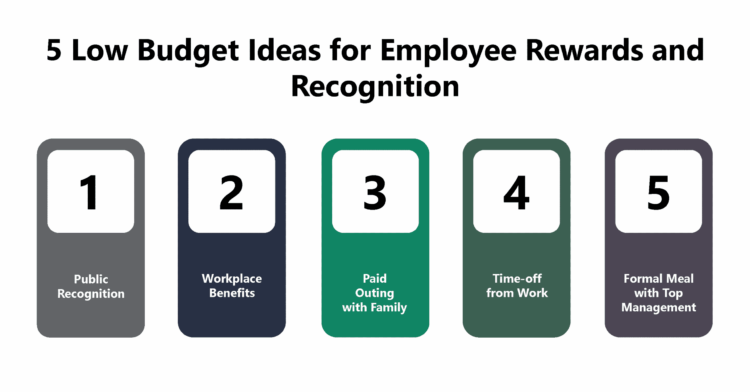1. Employee rewards and recognition programs can be highly effective even with a low budget, as the focus should be on acknowledging efforts rather than the monetary value of rewards.
2. Public recognition, workplace benefits, paid outings with family, time off from work, and formal meals with top management are cost-effective ways to boost employee motivation and engagement.
3. Simple gestures, such as public acknowledgment and personalized rewards, can significantly enhance employee satisfaction and loyalty.
4. These low-budget ideas allow organizations to create impactful recognition programs that resonate with employees without significant financial investment.
Employee rewards and recognition have emerged as practical tools for organizations to build an engaged workforce and drive growth. Despite this, many organizations are concerned about the costs involved in running such programs. However, there are many low-budget ideas for employee rewards and recognition that can work effectively.

The monetary value of employee rewards is not as important.
What matters more for employees is the fact that the organization is cognizant of their efforts and is looking to acknowledge and appreciate the same.
Whatever the budget, organizations should ensure that their programs align with employees’ expectations and interests.

Studies have received that well-thought-through, planned and executed rewards on a budget can be more effective in enhancing employee motivation rather than high-value rewards.

Around 85% of employees feel satisfied with a simple “thank you” for their daily efforts and accomplishments. Another study shows that 47% of employees prefer new growth opportunities as recognition for their achievements.

In a more recent study by Officevibe, 82% of employees feel that receiving praise for their work is better than receiving a gift.
Here are a few low-budget employee recognition and reward ideas that can help enhance employee motivation and engagement levels:
1. Public Recognition
2. Workplace Benefits
3. Paid Outing with Family
4. Time off from Work
5. Formal Meal with Top Management


Acknowledging and publicly appreciating the efforts and hard work of deserving employees is the most common and cost-effective method.
Hence, recognition should ideally happen in the presence of the team members of the employee or the entire workforce at a larger event.
Either way, employees feel a sense of pride and achievement, which can motivate them to further their performance.
Such recognition should ideally include a certificate of appreciation and some medallion or trophy.

Another cost-effective way to reward employees is to offer them certain desirable workplace benefits for a specified period.
The organization can extend the benefits permanently to repeat achievers, which will also serve as an aspirational example for other employees.
These benefits could include flexible work timings, free pickup, and drop facilities for a specific time, upgraded workstations or even paid training for skill enhancement.
Such rewards tend to inspire others, who can see the benefits gained by their peers thanks to their diligent and sincere efforts.

Most employees today struggle to balance their work and family lives. Additionally, family outings can be expensive, which is why the average employee tends to participate in them less frequently.
Hence, employees can be rewarded with a family outing at the organization’s expense. It is something that most employees would find appealing.
The organization can decide on the venue and type of outing based on the level of the employee receiving the reward.

The highly competitive work environments today often make it impossible for employees to take time off.
Hence, it can lead to their physical and mental exhaustion and even reduce their efficiency.
Hence, a great way to recognize employees could be to give them paid time off from work. Employees could stay at home or indulge in an activity that helps them to unwind and relax.
A few days off will ensure the employees feel genuinely acknowledged for their efforts.
It helps them feel valued, which in turn fosters a stronger bond with the organization.

A formal dinner with top management is an excellent, budget-friendly way to acknowledge and reward employees.
Most junior-level employees are in awe of top-level professionals. Hence, sharing a meal with them as a reward for their achievements can often prove to be quite motivating.
Moreover, this also provides the top management with opportunities to interact with high performers and assess their suitability for future roles.
Also read 8 Creative Ideas for Startups to Recognize Employees
There are many low-budget ideas for employee rewards and recognition that can make it possible for organizations to run such programs with a relatively low rewards budget and still get the desired results in the form of enhanced employee motivation and engagement levels.

Lead author: Sagar Chaudhuri, the Co-Founder and CEO of HiFives. He is an HR Tech Evangelist with over 25 years of experience in both corporate and entrepreneurial settings. Previously, Sagar has held leadership roles with companies such as Genpact, Infosys, and ICICI Bank. He has an engineering degree from IIT Kharagpur and an MBA from IIM Lucknow. Connect on LinkedIn